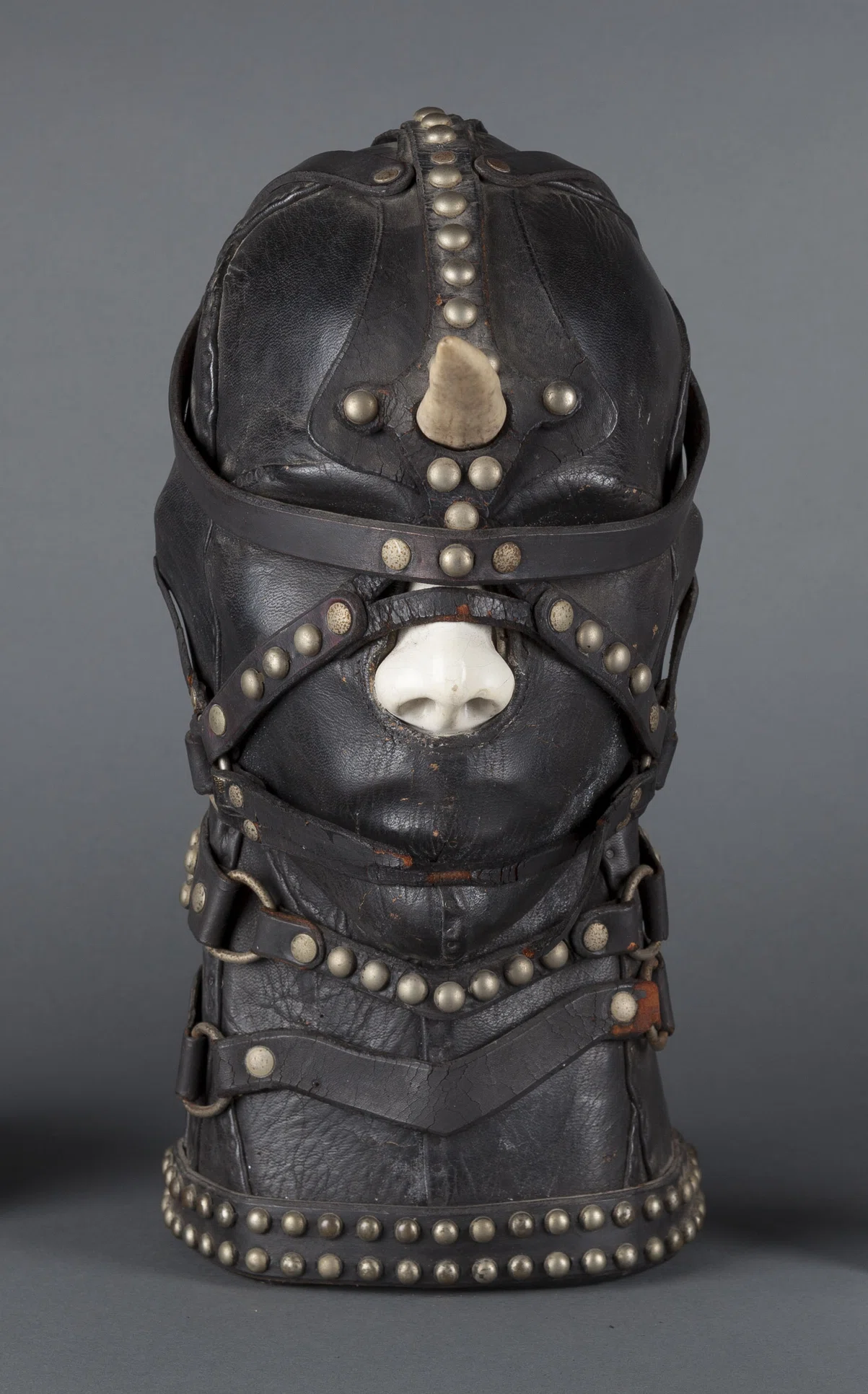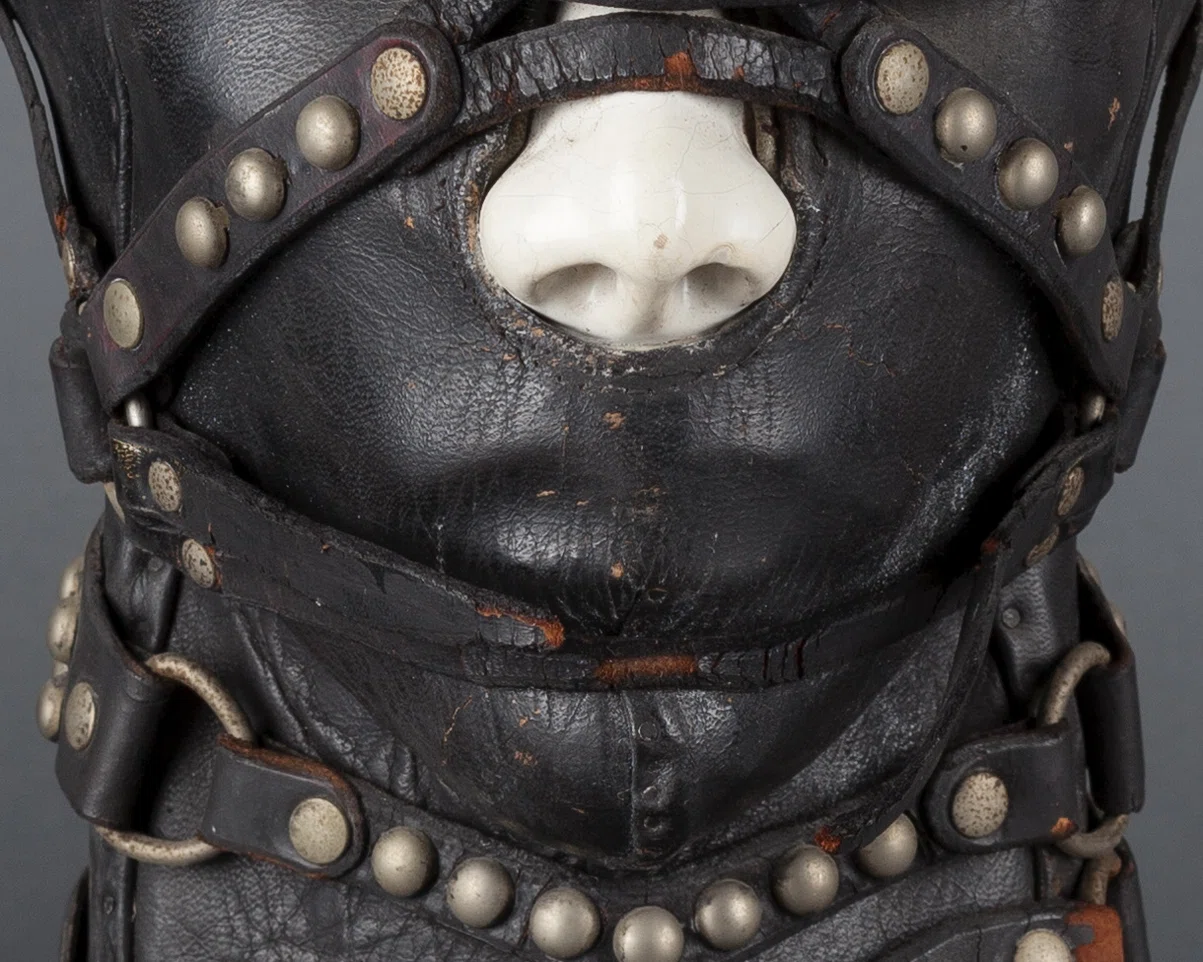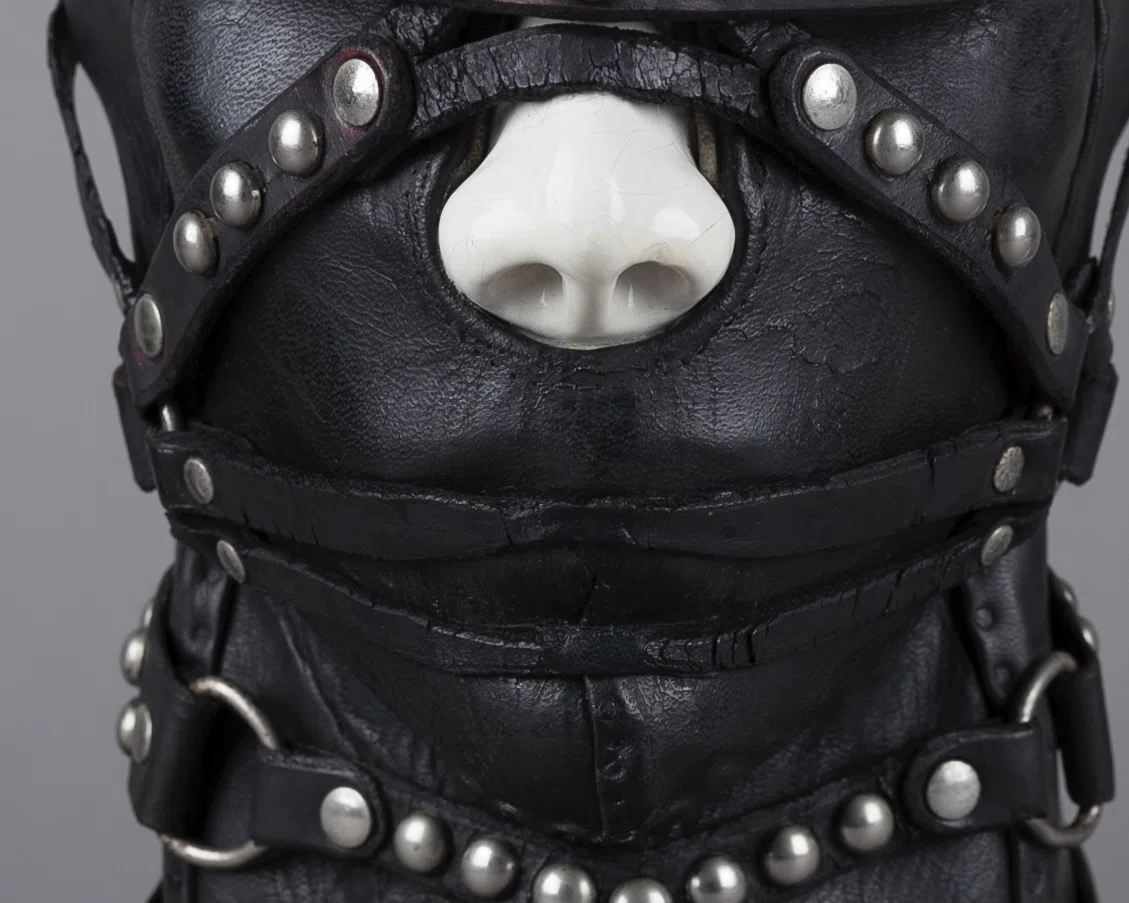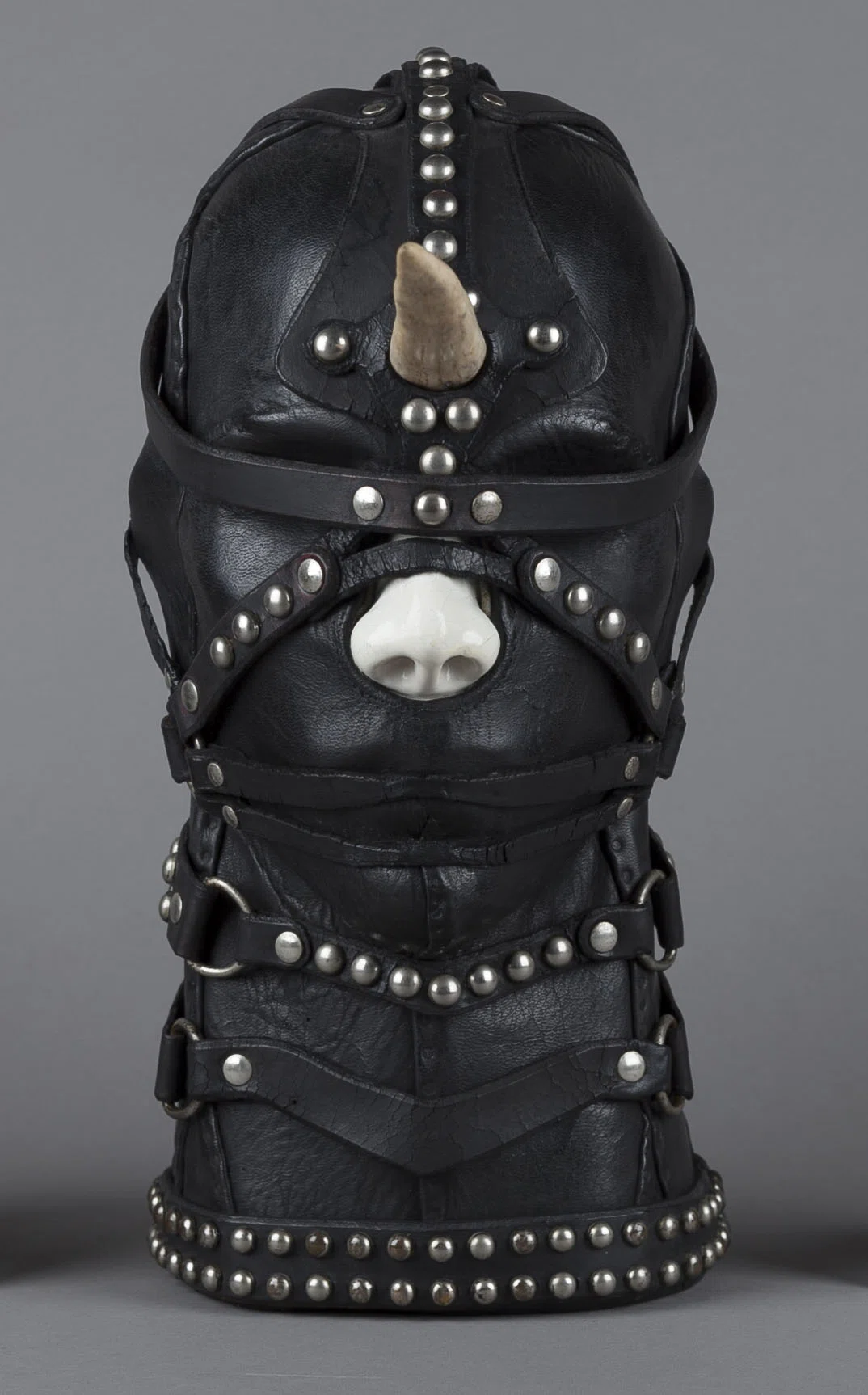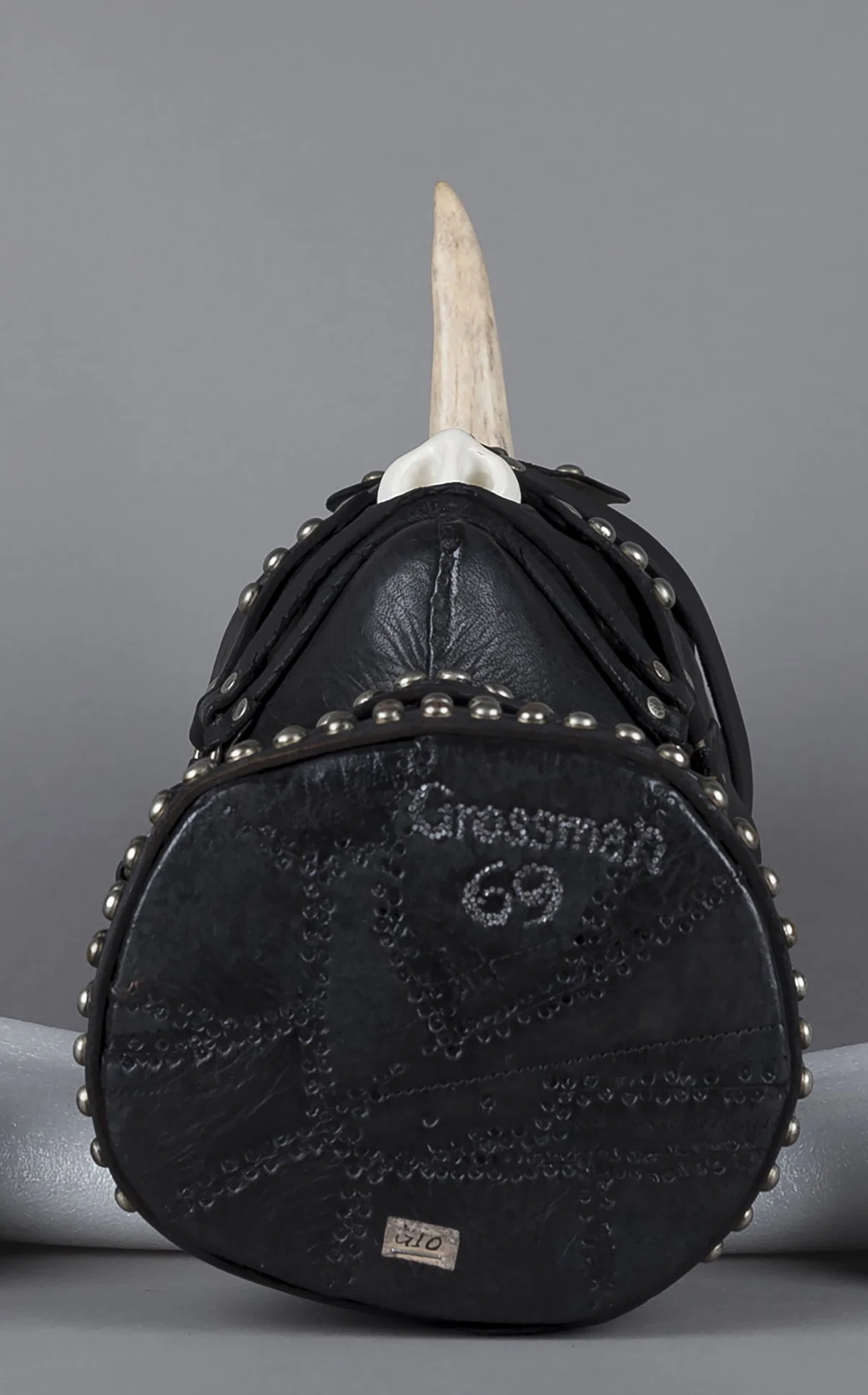
ART CONSERVATOR
DIGITAL
A PUBLICATION OF THE WILLIAMSTOWN + ATLANTA ART CONSERVATION CENTER
VOLUME 15. NO.2 BOOKS
TO
BUST
Books to Bust | Applying a Book Conservation Technique to a 3-D SculpturE
KRISTEN GILLETTE | ASSOCIATE CONSERVATOR OF OBJECTS
When multiple conservation disciplines share the same space as at the Atlanta Art Conservation Center (AACC), or the Williamstown Art Conservation Center (WACC), there is a great deal of exposure to techniques and materials unique to each specialty. This collaborative sharing is a great asset for problem solving and continual professional development of skills. While many mediums and methods do not apply between objects, paper, and paintings, there are numerous situations where the application of a technique from a different discipline is the missing link in a treatment approach. The following treatment is an example of this knowledge sharing, specifically, the application of a book conservation technique to a three-dimensional leather sculpture requiring structural and aesthetic repairs.
NANCY GROSSMAN + THE BUST
The sculpture is an iconic bust and base by the artist, Nancy Grossman, owned by a private client (figs. 1-2). Clad in perfectly fitted patched and seamed black leather, strapped in harnesses studded with nickel-plated brads, with an exposed nose coated in white enamel and a horn protruding from the forehead, the bust is striking, to say the least. Nancy Grossman is a New York-based artist who has been active since her graduation from the Pratt Institute in 1962 [1]. She gained early recognition for her well-known series of heads created with found materials such as telephone poles, leather jackets, harnesses, and buckles [2]. Grossman’s parents worked in the garment industry, and her early exposure was foundational in her work, as is visible in the precise seaming and fit of the leather around the features of the faces.
With many sporting spikes and horns, no two heads are alike, and no one is privy to Grossman’s process in-studio, which continues to this day[3]. There have been many influences cited from the Vietnam War [4] to African Tribal art [5], but many sources also state Grossman considers the pieces a form of self-portraiture [6]. In an interview, Grossman stated that “The most powerful part of a human body is the head,” and the early heads were “really important to [her]” [7]. The exposed, white enamel nose allows the sculptures ‘to breathe and be free to exist” [8].
The head treated at AACC is from this early period of Grossman’s career. Grossman’s signature in nails on the underside is dated ’69,’ the year the heads were first exhibited in New York City (fig. 2) [9]. It consists of two parts: a cylindrical base and the head (fig. 3). They are likely carved from the same piece of wood before being separately covered with the leather, which is secured to the wood substrate with nails and coated black. The horn protruding from the forehead is possibly antler, and the straps are likely equine or livestock harnesses and other repurposed material.
The condition of sculpture required treatment for each of the exposed materials, primarily the metal and the leather. The nickel-plated studs were tarnished and corroded, but the leather was in most need of intervention. The leather covering the face and that of the straps was brittle and cracking, with isolated areas of white bloom present on the surface. Numerous straps were exhibiting loss due to acidic deterioration (fig. 4). These areas were friable and unstable. One of the straps binding the mouth was broken and lacking the material to bring the ends back into contact. The desired outcome for the treatment of this sculpture was to stabilize and rejuvenate its aesthetic appearance. This would require substantial fills, both structural and visual, that would blend texturally with the existing leather surfaces.
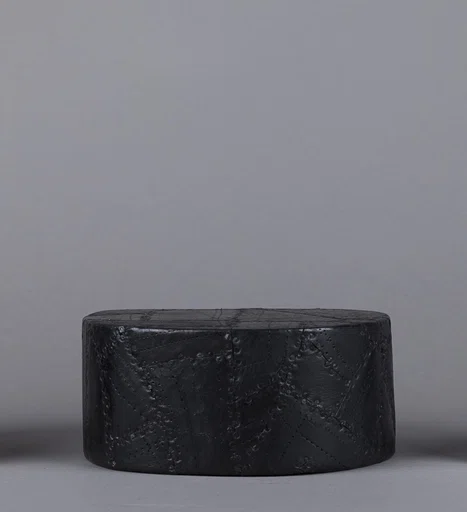
FIGURE 3. Post-treatment image of the bust’s cylindrical base.

FIGURE 4. Detail image of red-orange acid deterioration of leather straps before treatment. Note haze of white bloom around chin and tarnished studs.
CASTING METHOD
Snow Fain, the Associate Paper Conservator at AACC, suggested the use of a casting method developed for bookbinding repairs which utilizes acrylic paints, acrylic mediums and tissue backings that effectively repairs leather bookbinding while imitating the appearance of leather. The process was developed at the Barbara Goldsmith Laboratory of the New York Public Library and presented at the 2010 Annual Meeting of the American Institute for Conservation (AIC) [10]. It involves the creation of a silicone impression mold of a leather surface with similar grain patterns to the book cover requiring repair. A blend of acrylic mediums and paint are chosen for their visual (color, opacity, reflectivity, etc.) and physical properties (flexibility, strength, etc.). This blend is spread thinly over the silicone impression, effectively creating a faux leather acrylic film. Depending on the repair, tissue backings may be applied while the blend is wet on the mold.
Ms. Fain’s graduate dissertation work involved testing the light-fastness and mechanical properties of these fills through accelerated aging [11]. As such, she was familiar with the casting process, had physical examples to display the desired outcome, and assisted directly in the treatment of the Grossman head by demonstrating each step of the process.
This methodology was ideal for the Grossman bust for several reasons. The Grossman heads are aesthetically distinct. The leather is the primary reason for this due to its symbolic and visual interpretation. A more traditional fill, such as building up the substrate with layers of tissue and manually in-painting the surface, would be insufficient in the textural recreation of the surface. Easy adjustments to the acrylic blend, for flexibility and surface reflection provided an added bonus from this casting technique. The condition of the leather was not uniform throughout the sculpture. We can infer from the use of found leather that there are several states of manufacture, use, and, therefore, degradation. This is an indicator of why the leather straps were in poorer condition than the material covering the surface. As such, the fills required for the Grossman sculpture needed to be flexible but strong, with a backing that had good adhesion with the exposed fibrous substrate.
Collaborative sharing is a great asset for problem solving
and continual professional development of skills
GROSSMAN BUST TREATMENT
Prerequisite to applying the fills, the Grossman bust required cleaning and stabilization. The metal studs were lightly polished (to remove tarnish but leave the nickel plating intact), coated, and waxed. Iron corrosion was mechanically removed from buckles and rings, which were also coated and waxed to prevent future corrosion. Cracks and losses in the leather were consolidated with 0.5% Klucel® G w/v in ethanol. Several applications with a brush were necessary to stabilize the red-orange areas of friable acid deterioration and prepare the surface for repair with cast fills.
To create the casting mold, a box was constructed of Coroplast® and reinforced at the seams with hot glue. Two swatches of leather, with similar grain patterns to the leather on the head, were adhered to archival board. These were taped to the inside of the box. Rebound® 25 Smooth-On Silicone Rubber was mixed according to the manufacturer’s instructions. A thin layer was brushed over the surface of the leather swatches to prevent bubbles and capture as much definition as possible before gently pouring the remaining silicone overtop and leaving it to set (figs. 5-6).
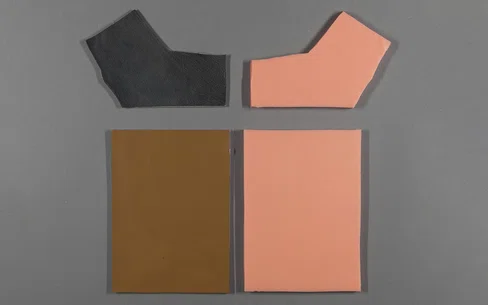
FIGURE 5.
The completed silicone molds with their leather samples adhered to archival boards. Two distinct grain patterns were chosen to blend with the various patterns present on the bust’s found leather construction.
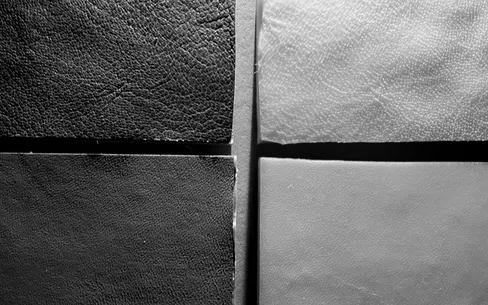
FIGURE 6. A black & white raking light detail of the silicone molds (right) to show the impression of the leather grain from the samples (left)
The flexibility in the original ratio was desirable for this treatment. Consequently, the variables in the casting tests were surface reflectivity and backings. Two blends in different colors were mixed to cast, one with matte gel medium and one with semi-gloss gel medium. Semi-gloss medium was chosen for casting, although the impressions themselves showed little differentiation in reflection. In its previous use in book conservation, the cast fills were applied to much thinner leather substrates. There arose a subsequent question of backings for fills on the thick straps of the Grossman head. The samples tested three backing materials: Japanese tissue, lens tissue, and unbleached cotton muslin (fig. 7). Although muslin was not used in the original procedure, it was possible that the density and strength may lend good structural qualities to the Grossman head repairs. However, it was found to be too thick to make defined edges and adhere properly. Consequently, Japanese and lens tissue were the backings cast for repair.
It was essential to match the color tone prior to casting the fills. Tests were completed by mass-based ratios, applied to mylar and allowed to dry fully before comparing to the Grossman head (fig. 8). Over ten ratios were tested and a ratio was chosen which was a good match for the leather as a whole (3g carbon black, 1g burnt sienna, 1g ultramarine blue, & 0.2g titan buff). This ratio was scaled up and provided the base color for various in-painting mixtures in addition to the cast fills. The fills are cast by spreading half of the mixture of paint, medium, and GAC 500 over the mold with a spatula and leaving it to dry before spreading the remaining mixture over the top [13]. This allows the mixture to capture all of the fine detail of the mold. The tissue backings are applied to the second layer while wet.
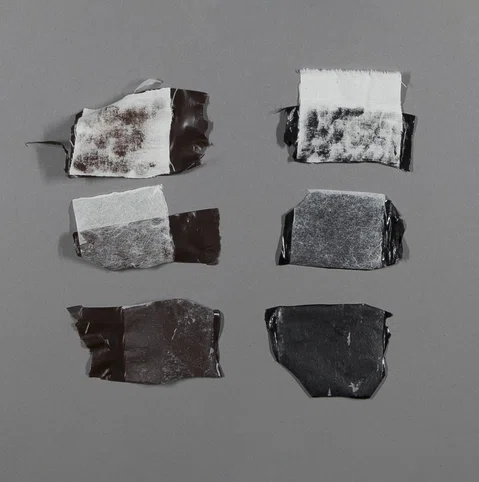
FIGURE 7 .
Examples of the cast leather tests with three different backings. From top to bottom: Muslin, lens tissue, and Japanese tissue.

FIGURE 8.
Ten blends of Heavy Body Acrylic Paints applied to mylar to color match the black of the bust’s leather.
The completed fills were trimmed and cut to shape (figs. 9-10) before adhering with a 1:1 mixture of Lascaux® 498 HV and Lascaux® 303 lightly diluted to a workable consistency with Lascaux® Medium for Consolidation (MFC). The 498HV provided strength and integrity to the bond, while the 303’s slight tackiness when dry prevented lifting. The MFC provided additional substrate consolidation and dilution without diminishing the strength of the adhesive (as opposed to water). The thinner strap along the proper right ear was very fragile and had very little surface for the join. 20% (w/v) Paraloid® B72 in acetone was required to create a bridging repair with the cast fills. Several straps required additional stabilization through the application of tissue to their undersides with methyl cellulose or Lascaux® 498 HV. Further aesthetic integrations were completed using blends of the color-matched acrylic paint and varying mediums/additives (i.e., GAC 200 for the nails, matte medium versus semi-gloss).
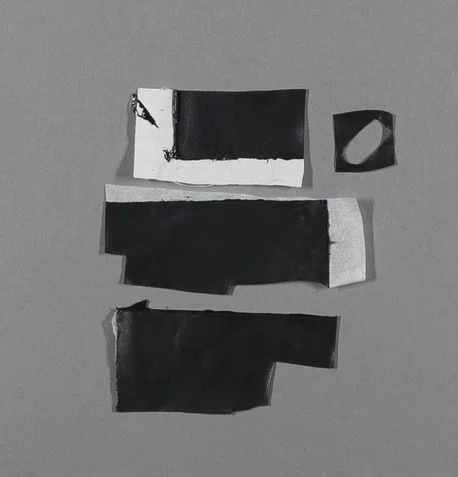
FIGURE 9.
The final cast fills with various backings.
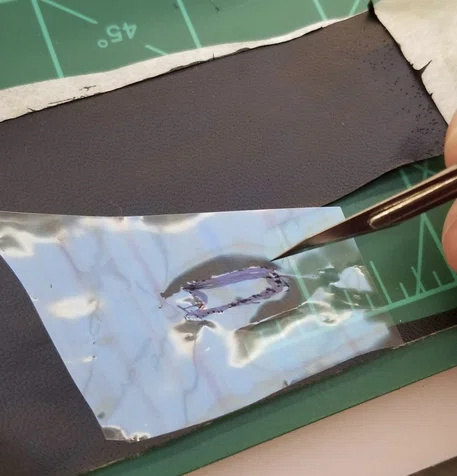
FIGURE 10.
A detail of the shaping process of the acrylic fills. The shape of the loss was traced with mylar or acid free tissue. The tracing was transferred to the acrylic fills by dotting along the outline with a scalpel. The outlined shapes were cut out and their edges were beveled from the back to front with a knife to integrate smoothly with the perimeter of the area being repaired.
CONCLUSION
The integration of the cast leather fills was successful aesthetically and structurally (figs. 11-16, slideshow). It allowed for flexibility and strength in repair, a conservation priority, while simultaneously rectifying the visual impact of the sculpture, drawing the eye to the whole rather than localized condition issues. As a fairly recent technique in the conservation field, the applications for this casting method are still being developed and fine-tuned to suit diverse situations. In the field of paper conservation, the technique is being tested for use with alternative casting materials, such as BEVA® 371 for which research is still ongoing [14]. The expansion into other conservation disciplines has just begun. This treatment has highlighted ways in which the technique may be used in the conservation of three-dimensional objects and how that may differ from its original use with books. Books are more often handled, moved, and flexed. Three-dimensional artworks require a different approach when it comes to choices in adhesives, backings, and flexibility, as they may not be handled often, but rather require substantial stabilization. The introduction of this technique initiated by a paper conservator to an objects conservator is evidence of the need to foster further through open discourse between conservation disciplines to the benefit of the field as a whole. Acknowledgement
Many thanks to the owner of this fantastic sculpture for giving permission to share images and treatment information. Considerable thanks are due to Snow Fain for introducing the method and providing hands-on training, which was key to its successful application. Thanks also to Ségolène Girard for sharing her further research into this technique.
Photography Credit
| Kristen Gillette and Maggie Barkovic (Cover)
REFERENCES
[1] “Nancy Grossman,” Brooklyn Museum of Art, accessed April 13th, 2021, https://www.brooklynmuseum.org/eascfa/about/feminist_art_base/nancy-grossman.
[2] Nancy Grossman: Heads,” The Museum of Modern Art (MoMA), accessed April 13th, 2021, https://www.moma.org/calendar/exhibitions/3778.
[3] “Sculptor Nancy Grossman Tells Yvonne Rainer About Her 50 Years of Crafting Radical Human Shapes,” Interview Magazine, accessed April 13th, 2021, https://www.interviewmagazine.com/art/nancy-grossman-tells-yvonne-rainer-about-her-50-years-of-crafting-radical-human-shapes.
anuel Training School
[4] MOMA, “Nancy Grossman: Heads.”
[5] “Nancy Grossman’s Bust,” Artsy, accessed April 13th, 2021, https://www.artsy.net/nashersculpture/article/nasher-sculpture-center-nancy-grossman-bust.
[6] Brooklyn Museum, “Nancy Grossman.”
[7] Interview Magazine, “Sculpture Nancy Grossman.”
[8] IBD.
[9] “Nancy Grossman: Tough Life Diary,” Tang Teaching Museum, Skidmore College, accessed April 13th, 2021, https://tang.skidmore.edu/exhibitions/73-nancy-grossman-tough-life-diary.
[10] Grace Owen and Sarah Reidell, “Cast Composites: A System for Texturing Repair Materials in Book Conservation,” in Topics in Photographic Preservation, Volume 14, ed. Camille Moore and Jessica Keister (Washington, DC: American Institute for Conservation of Historic & Artistic Works), 250-262.
[11] Snow Fain, “Investigating the Light-Fastness and Mechanical Properties of Synthetic Leather made with Golden® Acrylic Products after Accelerated Aging,” MA Dissertation, (West Dean College, 2015).
[12] Owen and Reidell, “Cast Composites,” 254.
[13] IBID, 255-56.


